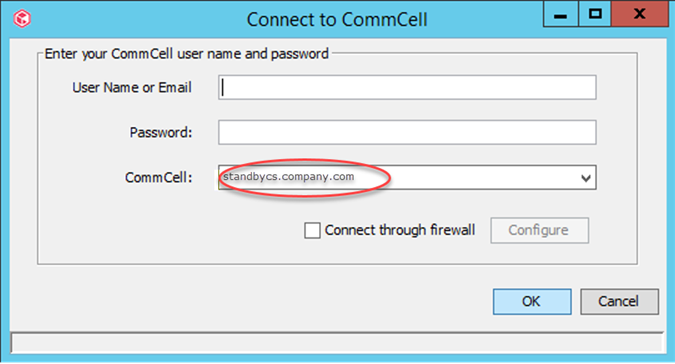Maintenance failovers can be used to temporarily halt all activities except restores in the CommCell. Use this option to perform maintenance related activities without completely shutting down the CommServe server (for example, to install platform releases on the production CommServe host).
Before You Begin
-
Make sure that the SQL Client from both the production and standby CommServe hosts can communicate with the CommServe and with each other.
-
All the clients in the CommCell must be able to reach the standby CommServe host after the failover, either through a proxy or any other method used to communicate with the standby CommServe host.
-
If the CommServe is currently in a "lockdown" mode where client certificate authentication is forced during installation, reset the CommServe lockdown by setting the Force per-client certificate authentication option to No from the CommCell Console > Control Panel > Certificate Administration dialog box. (This setting can be re-enabled once the failover is completed.) For more information on client certificates, see Client Certificates - Enforcing Authentication of Client Certificates during Installations.
Procedure
-
Log on to either the production CommServe host, or the standby CommServe host.
-
Open command prompt and navigate to the folder associated with the SQL client:
For example: opt/commvault2/Base
-
Execute the following command to perform a maintenance failover to the SQL client in a standby CommServe host.
./CvFailover -OpType Failover -FailoverType ProductionMaintenance -TargetNode StandbySQLClientSyntax:
./CvFailover -OpType <OpType> -FailoverType <Failover Type> -TargetNode <Target Node Name>Where:
-
<OpType>can be one of the following operations:Failover - To perform a failover operation.
GetFailoverConfig - To display the failover configuration status.
ResetFailoverOperation - To reset a partial failover operation.
ResetFailoverConfig - To reset an existing failover configuration. (To be used in case of xml corruption.)
-
<Failover Type>can be one of the following failover types:Production - To perform a production failover.
ProductionMaintenance - To perform a maintenance failover.
MaintenanceFailback option - To reset maintenance failover.
Test - To perform a test failover.
TestFailback - To reset a test failover.
-
<Target Node Name>is the name of the target SQL client in the CommServe host to which the operation must be failed over. -
-forceUnplannedFailover can be used when the setup is stuck and only when the target node is the node with latest database, to avoid major data loss.
-
Result
The failover is initiated and the sequence of tasks performed during the process is displayed.
Note
After the maintenance failover, only restore operations are allowed in the CommCell. All other activities, including installation, should not be performed.
What to Do Next
-
After a successful failover, make sure to open the CommCell Console and/or Command Center from the new active CommServe host. Make sure to connect to the currently active host in the CommCell box displayed in the Connect to CommCell dialog box.

-
If you have failed over to a CommServe host located in a Cloud, or behind a firewall where port 8401 (GxEvMgrS port) is not reachable, make sure to enable the Connect through firewall option, click the Configure button, and then specify the proxy computer details in the Proxy hostname or IP address and Proxy port number boxes. Ideally this proxy computer must be a standalone computer which is accessible to both the CommServe host and the clients.
-
You will notice the following in the CommCell Console:
-
All activities, except restores, are disabled.
-
All the jobs will appear as Suspended in the Job Controller. (However, you can start and perform restore operations from this CommServe host.)
-
Related Topics
-
Production failovers can be performed to alternate between the active and passive CommServe hosts. For more information, see Performing Production Failovers.
-
Test failovers can be performed to test the failover process and to verify that the services are successfully started in the standby CommServe host after a failover. For more information, see Verifying Disaster Readiness.